How to Visit Uplistsikhe Cave Town as a Day Trip (2024)
The ancient Cave Town of Uplistsikhe is the only Classical Antiquity site in Georgia still standing above ground and easily accessible.
If that’s not a reason enough to visit it, consider the fact that it’s veiled in legends and myths from before the onset of Christianity.
It’s very near the city of Gori and also quite close to Tbilisi too! You can easily visit Uplistsikhe Cave Town as a day trip from either of those cities.
Here’s how to do that by yourself and my recommendation for the best organized tour (it’s this one from Tbilisi including Mtskheta).
The Legend of Uplistsikhe
Uplistsikhe is one of the oldest human settlements in Georgia and as such its early history is unknown. That’s why Medieval Georgian writers ascribed it a legendary status and invented a mythological foundation story.

The most famous legend tells of a certain mythical Kartlos, a king who birthed the Georgian people. Did you know that Georgia in Georgian is called “Sakartvelo”? Yes! It means The Kartvelians or the people of Kartlos.
Kartlos had 8 sons, of which the most lauded was Mtskhetos, the founder of, you guessed it, Mtskheta.
And lastly, Mtskhetos had 3 sons of his own, the one most important for us was a leader named Uplos. Thus came the name Uplistsikhe – the Castle of Uplos.
How to get from Gori to Uplistsikhe
There’s a bus that goes to Uplistsikhe Cave Town from the Intercity Bus Station in Gori, in the north part of town.
To get to the terminal you can take a public bus from the bus stop opposite the Public Service Hall. You can pay for public transport in Gori with a contactless card: just tap the terminal inside the bus. It costs 0.5 GEL (0.2$).
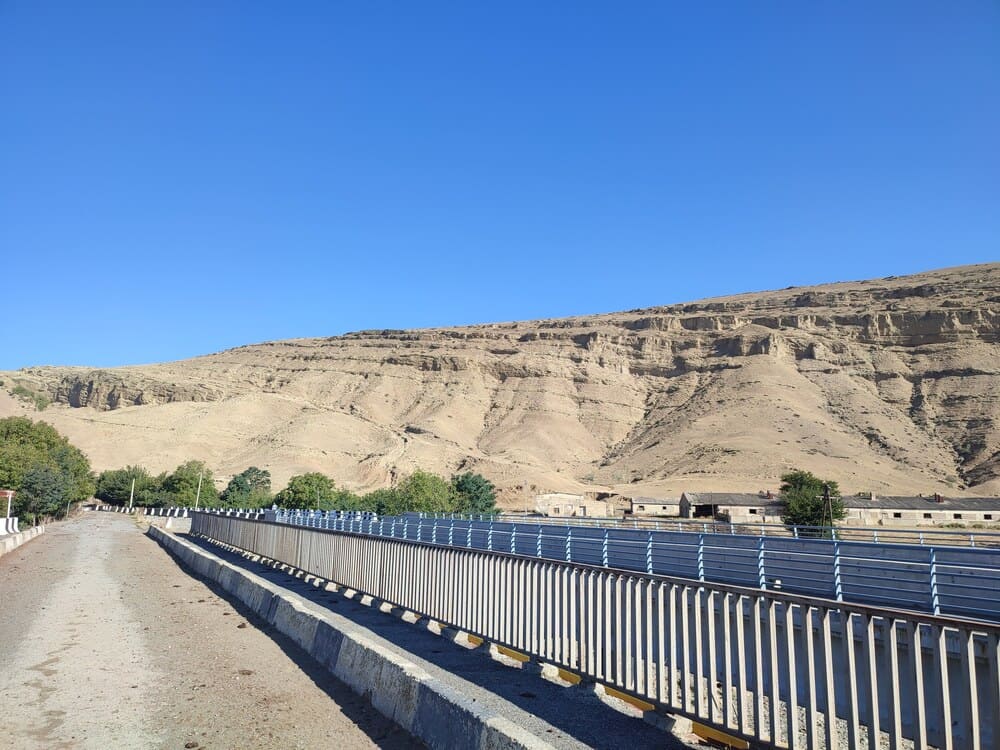
At the Central Bus Station, ask for the bus to Uplistsikhe or look out for a sign. When I went there I noticed the sign in Latin letters spelling out “Uplistsikhe”, but no minibus.
I asked the people loitering about in the area and they told me to wait. Sure enough, 15 minutes later the minibus arrived.
The minibus from Gori to Uplistsikhe costs 2 GEL/0.75$ and is payable in cash only.
Getting back to Gori
Getting back to Gori can be a bit tricky. The bus only comes once every hour or every two hours.
You can stop the minibus anywhere on the main road towards Gori by simply waving your hand at it.
When I was there, I thought about walking back to Gori through the plains. There are trails and it would take around 2 hours.
Ultimately though, I decided to go wait for the minibus. I waited for 25 minutes at which point I got quite frustrated and decided to hitchhike instead. It wasn’t long before an old Lada picked me up.
Well, actually it was a taxi with passengers onboard already. I ended up paying 2 GEL anyway. But at least I didn’t have to wait any longer.
How to get from Tbilisi to Uplistsikhe
There are no direct minibuses between Tbilisi and Uplistsikhe. To get from Tbilisi to the cave town, you have to first get to Gori, then hop on the marshrutka to Uplistsikhe.
By yourself using public transport
Regular minibuses run between Tbilisi and Gori. Simply go to Didube Station (connected to the Tbilisi Metro), walk out, and into the bus station. Look out for signs that say Gori and ask the attendant to make sure.
Minibuses bound for Gori depart every 20-30 minutes every day, the earliest being at 7 AM.
The minibuses end their route at Gori Bus Station. From there take the direct minibus towards Uplistsikhe as explained above.
Organized tour
If traveling in Georgian marshrutkas is not your thing, consider joining an organized tour. You can book them at practically any corner in Tbilisi (there are so many travel agents in the Old Town).
Most of them combine Uplistsikhe with Mtskheta and Gori. Here’s my recommendation.
Uplistsikhe opening times and entrance fee
Uplistsikhe may be a cave town that’s survived a couple of millennia, but it’s also a museum with strict opening and closing times. These depend on the season:
Opening Times
- 16 April – 30 September: 10 am to 7 pm;
- 1 October – 1 November: 10 am to 6 pm;
- 2 November – 15 April: 10 am to 5 pm.
Ticket prices and add-ons
The standard ticket costs 15 GEL (5.7$) or you can add a short wine-tasting session and make it 20 GEL (7.5$). I opted to try the wine and I can say the wine tasting is worth the small premium.
There are also other add-ons. You can hire a private guide to tell you about Uplistsikhe, its history, and significance for 45 GEL (17$).
If that’s too much, consider an audio guide for 15 GEL (5.7$). Information on the site is sparse, so depending on your interest, an audio guide could be worth it.
Or you can save some money by reading the main points in the rest of this article.
What’s inside Uplistsikhe?
After paying for your ticket and entering, you’ll see a small museum to your left.
It has the main information about Uplistsikhe, some short videos you can watch as well as some of the unearthed artifacts.
Afterwards, the path is clearly indicated.
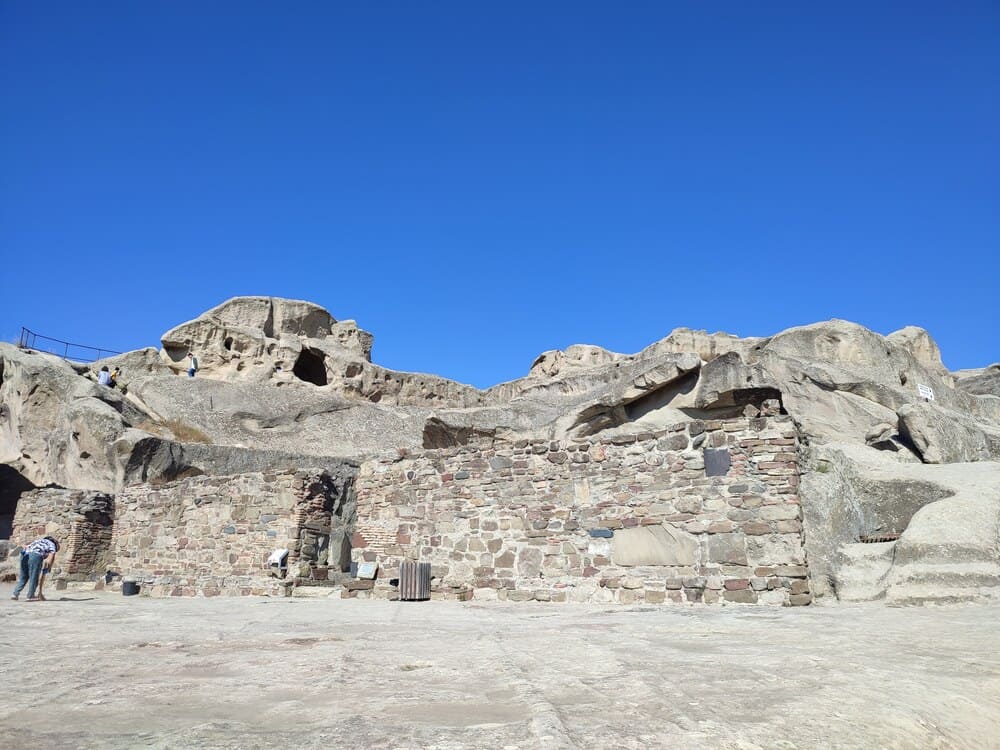
Make sure to first go through the tunnel on the far side of the complex, then explore the ancient ruins. It’s much cooler than taking the stairs straight up.
Uplistsikhe is not a big place. You can cover all of it – The Hall with the High Throne, the Grand Hall, the Apothecary, and the Prince Church in less than an hour.
For a more laid-back visit, consider spending around 1.5 to 2 hours on the site, inclusive of the 10-minute wine-tasting session (if you bought the add-on).
Main highlights of Uplistsikhe Cave Town
Uplistsikhe is a cave town, the focus here being on “town”, although it feels more like a castle. It has grand halls, temples, churches, and cathedrals (from later periods), a cool tunnel (both literally and figuratively), a theater, a ton of caves, and a whole lot of engravings on the walls.
Hall of Queen Tamar
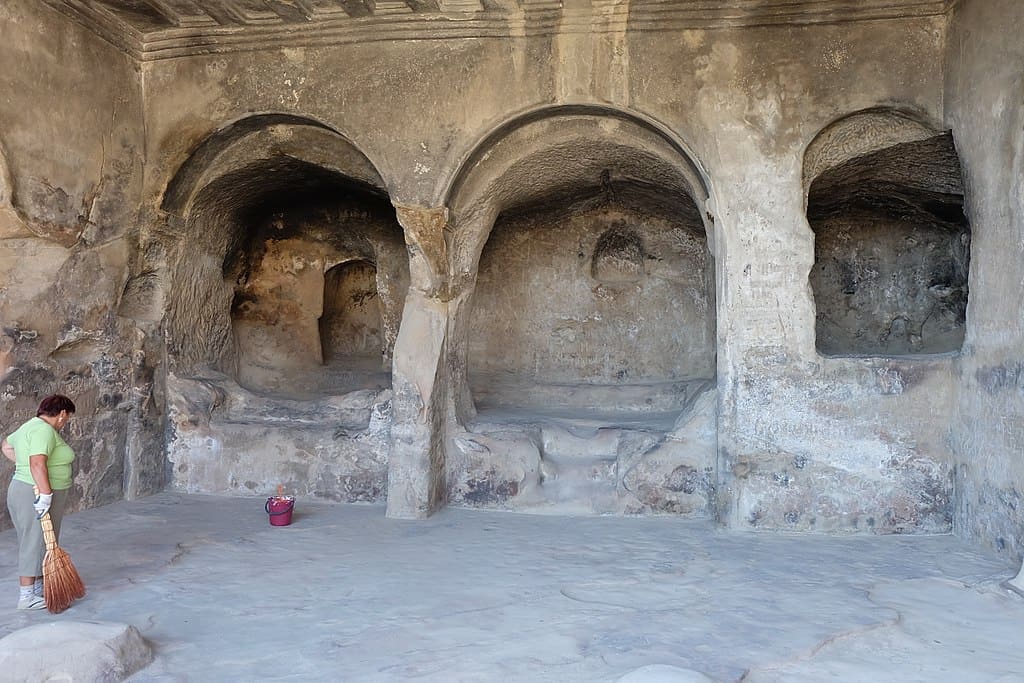
Queen Tamar is one of the most important historical figures in the history of Georgia! She ruled the country at the end of the 12th and beginning of the 13th century and her reign is associated with a period of political and military successes and cultural achievements.
You’d be excused to think she lived in Uplistsikhe, owing to the hall named after her. But no, she didn’t – Queen Tamar ruled from Tbilisi and was buried at Mtskheta.
Queen Tamar Hall is named so because of its opulence and resemblance to a similar hall that she used temporarily in the cave town of Vardzia.
There are many other places in Georgia named after her, a good example is the Queen Tamar Tower in Ushguli.

It is not a royal hall per se, but more of a ritualistic temple.
Do not miss the massive wells right outside the Hall used for winemaking and storage.
Ancient Theater
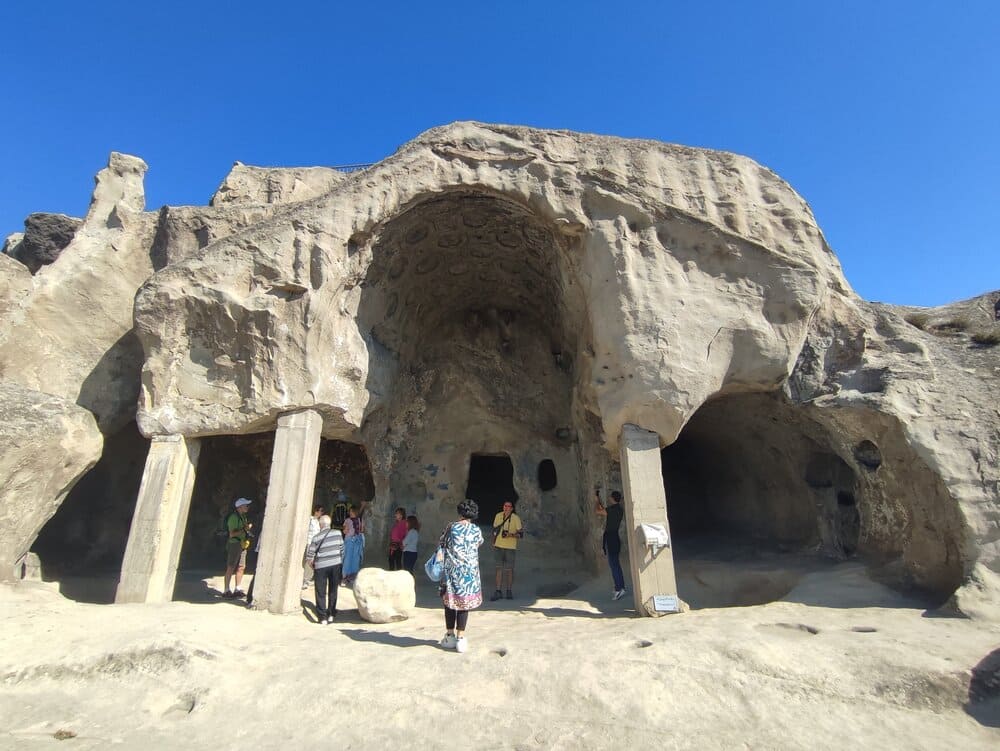
The Ancient Theater has a triangle roof and easily recognizable columns. Again, you’d be excused if based just on the name you thought it was an actual theater for performances, but a quick look at it and you realize it’s way too small for that.
The short answer is that we don’t know for sure. Most likely it was rituals and pagan worship. Potentially even small private ‘shows’ if we can even call them that.
At the end of the day, it’s a pretty cool building.
Caisson Hall
The central part of the Theater is called Caisson Hall. What’s unique about it is the hexagons that are carved on the walls to fully cover the plain. Take a look at the picture above.
It’s called “tesselation” in maths and has been a subject of exercise for mathematicians for millennia.
Church of the Prince
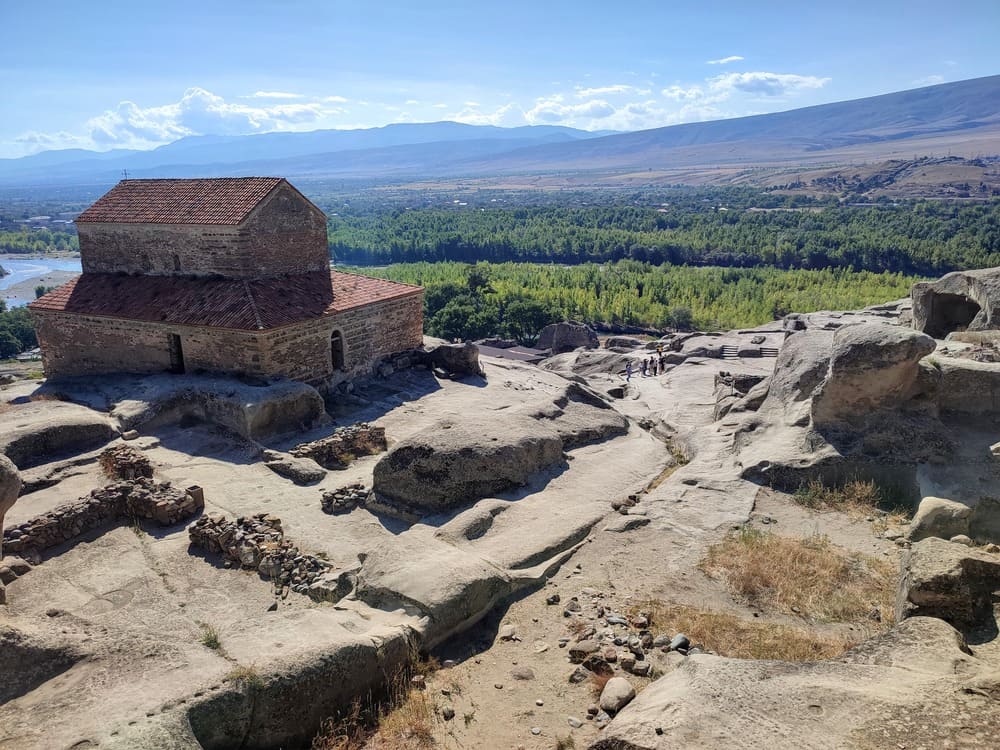
Moving on to later periods (after all, when Uplistsikhe was founded there was no Christianity), the Church of the Prince dates from the 10th century. I have no idea why it’s called this and who the prince in question is. Maybe there was no prince at all, who knows?
Consider that the Mongols ravaged the Caucasus in the 13th century destroying everything in their path. Somehow, someway, the Prince’s Church survived that!
When the Mongols reached Uplistsikhe, they killed all the monks. Sad.
Three Nave Christian Basilica

Right below the Church of the Prince, you can see the Christian Basilica, kind of modern-looking. It used to be a pagan temple until sometime in the 10th century when the residents transformed it into a Christian temple.
Temple of Makvliani
The Temple of Makviliani was the main pagan worship center of Uplistsikhe, dedicated to the Sun Goddess.
The temple is spacious and has many chambers cut into the rocks. Some additional brick walls were added later.
Very little is known about what the people worshipped or what the rituals looked like. One can only imagine while walking through the stone corridors.
The Tunnel
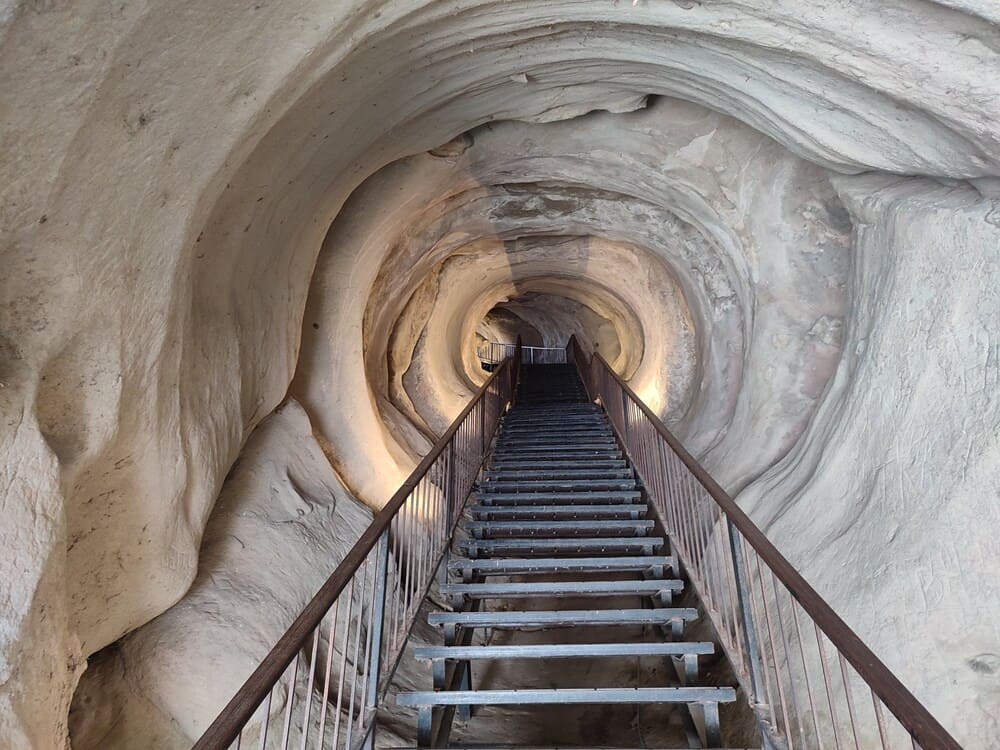
The tunnel was used by ancient residents as a way to quickly escape the town should the need arise.
Today, the tunnel is strengthened and the main route through Uplistsikhe’s main sites ends at it. My advice is to begin by climbing through the tunnel – it feels cooler, no particular reason, but just trust me.
The Plains of Uplistsikhe (Ancient citizens’ town)
Uplistsikhe might feel small for a city. That’s because what remains open as an open-air museum today is only the residence of priests or shamans, later Christian monks, and any higher-class individuals.
Every day people lived in the lower areas surrounding the cave town of Uplistsikhe. Closer to the water they could focus on agriculture and raising livestock.

Today almost nothing is left of their dwellings. The area around Uplistsikhe is plains with low vegetation and the few short mounts hint at the ancient history.
There’s a trail from Uplistsikhe towards Gori that passes through the plains. It takes around 2 hours to walk back to Gori.
